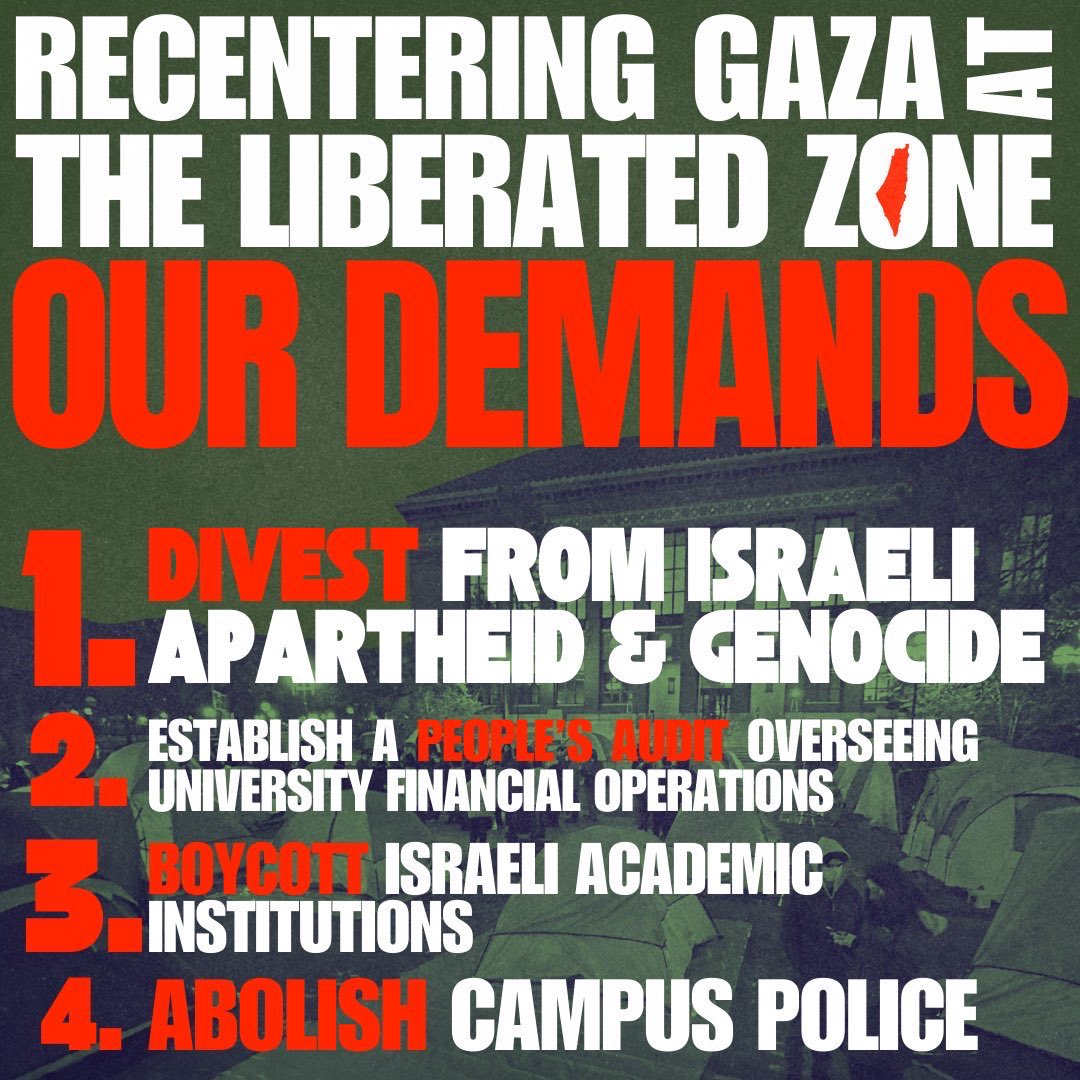Ivan Drury Zarin
Posted May 21, 2024

UPDATE: The University of Michigan encampment Telegram channel reports: “This morning at 5:45 am, Michigan State Police and DPSS raided the encampment. Riot cops pushed back students and community members and attacked with pepper spray repeatedly. As the cops cleared the encampment and arrested 4 protesters, with 2 protesters also hospitalized, and others injured, [UM President Santa] Ono wrote a lie-filled email to the UM community condoning the violence against us.”
After 23 days on the University of Michigan Diag, the Gaza Solidarity Encampment is facing down a double threat. The longer-standing danger is containment, as University Regents have refused to meet with the camp occupants or discuss their demands. And now, as administration’s hopes that the camp would fade away after graduation prove false, there are rumors circulating about a coming police raid.
On May 15th, hundreds of people gathered in the camp on the Diag to commemorate the 76th Nakba Day — recognizing the social cleansing of Palestinians from their homeland that was the condition for establishing the state of Israel. I had been at the camp two nights before because they had called for a presence from the community, for safety in numbers, after hearing that the university was planning a police attack that night. It ended up being a false alarm — the police didn’t come. But when I walked through the camp gates and into the Nakba Day rally with my son on my shoulders, there was still a sense of tense anticipation in the air.
I had felt it before, but this time, because of that tension and the lingering threat of displacement, I really felt grateful for the presence of the encampment. University presidents, politicians, cops, and media pundits really push the idea that only students belong on campus, and smear non-students at camps as “outside agitators.” But the truth is that students have taken the political and strategic lead in the Gaza solidarity movement — that student encampments are nodal sites of the movement as a whole.
For seven months, the Gaza solidarity and antiwar movement took the form of weekly rallies and marches, and then direct action blockades, and divestment motions in city councils and union halls, and “uncommitted” political actions. The genius of the student encampments has been that they are a form of action that is as constant and ongoing as Israel’s genocidal war on the Palestinian people. If not for the camp as a base, where would the Nakba Day rally have taken place? And where would we go when the rally ended?
Sustaining the encampment on the Diag where it is rooted, and keeping it a militant, disruptive force in the life of the campus and the city has become an issue for the movement for Gaza, not only for the student organizations that originally organized it.
One of the speakers at the rally, Salma Hamamy, president of Students Allied for Freedom and Equality (SAFE), addressed these challenges directly. “Today marks 23 days of our solidarity encampment, with no response from the U-M Board of Regents,” she said. “As our Regents have entirely ignored their students for the last seven months, students have decided to continue with the pressure campaigns to demand divestment.”
She was referring to the action the camp had organized early that morning, when they delivered demand letters to the homes of all six U-M Regents. The university quickly released a public statement denouncing this action, saying, “The tactics used today represent a significant and dangerous escalation in the protests that have been occurring on campus. Going to an individual’s private residence is intimidating behavior and, in this instance, illegal trespassing. This kind of conduct is not protected speech; it’s dangerous and unacceptable.” This sort of denunciation could be read as preparing the political ground for a police attack on the encampment.
But what choice does the Gaza Solidarity Encampment have? Hamamy explained that U-M Regents have ignored demands and requests to meet from students for seven months, long before the encampment started. Meanwhile, she said, “For the last seven months I have woken to the news of my family members’ deaths in Gaza. Gaza is seven hours ahead of us in time and each morning I am confronted with the reality of being physically distant, separated, and isolated from them, and also too far behind in time.”
Hamamy said the “distinction in time, space, and utter reality, between Gaza and everyone everywhere else” seems to allow people “responsible for the financial investment in their deaths,” like U-M Regents, “to sleep soundly.” So, because “the Regents have refused to come to the encampment, we are now bringing the encampment to them.”
The U-M Regents don’t want students to march on their houses. They also don’t want students to interrupt graduation ceremonies, or to picket outside their dinners, or to rally with non-students at the encampment, or to have an encampment site at all. But the point of the encampment is to do exactly what the university Regents do not want you to do — that’s the only leverage students have in their fight to divest their massive endowment from investments in Israel’s settler colonial genocide.
In order to fight the containment of the camp, students are staying disruptive and building pressure on the university to meet their demands. And in order to fight displacement, which the university threatens in order to pressure the encampment to slip into containment, students are uniting with and relying on the support of the broader Gaza solidarity movement.
The creative and bold disrupt-and-defend maneuvers that student organizers deploy at the Gaza Solidarity Encampment show and rely on the organic interconnection between the campus movement and the broader mass movement that is fighting Israel’s genocide. For students to continue to take the offensive and build pressure against university administrators, it’s up to the rest of us to show up and support them when it’s time to defend these hard-won encampment spaces.
